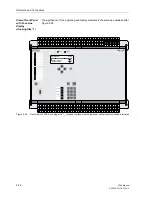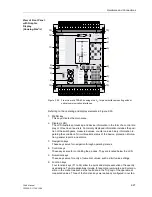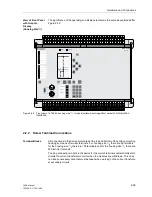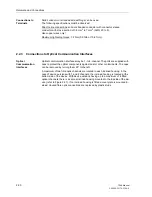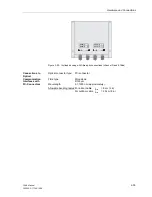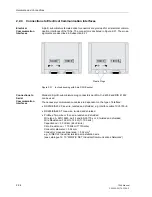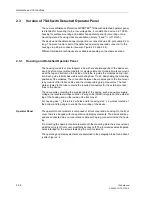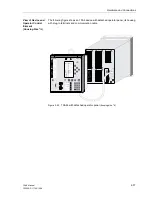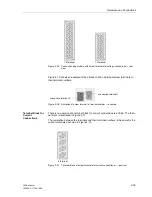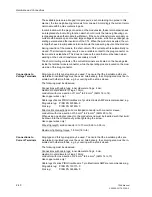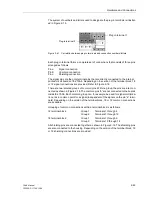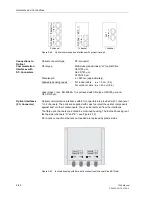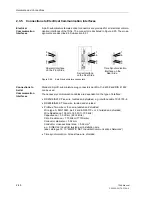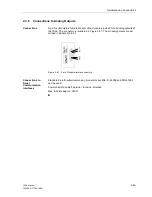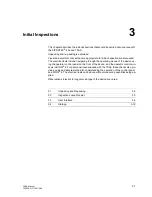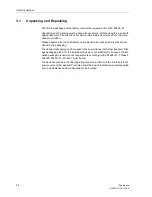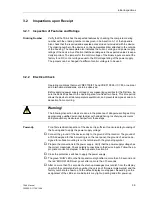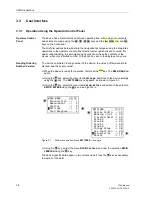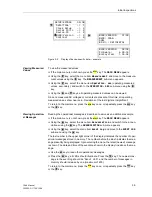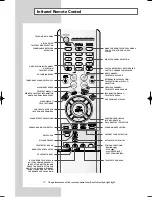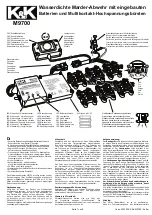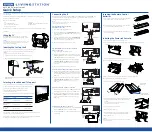
Hardware and Connections
2-40
7SA6 Manual
C53000-G1176-C156-2
The available poles are arranged into pole pairs, each containing two poles. In this
manner, the two neighbouring terminals form one pair. Accordingly the current termi-
nal module with 8 poles contains 4 pairs.
In combination with the plug connection on the module side, these terminal pairs have
an integrated short-circuiting function which short-circuits the two neighbouring cur-
rent passages when the module is withdrawn. If the current transformer secondary cir-
cuits should become open circuited, large voltages can arise, which may endanger op-
erating personnel and the insulation of the CTs. When the module is inserted, the cur-
rent paths have a low impedance termination via the measuring inputs on the module.
During insertion of the module, the short-circuit of the current path is automatically re-
moved. The interruption only occurs once a reliable contact to the plug connector on
the module is established. This does not reduce the care that must be taken when
working on the current transformer secondary circuits!
The short-circuiting contacts of the current terminals are located on the housing side,
inside the terminal module connector, while the operating pins are located on the mod-
ule side of the plug connector.
Connections to
Voltage Terminals
Ring-type and fork-type lugs may be used. To ensure that the insulation paths are
maintained, insulated lugs must be used. Alternatively, the crimping area must be in-
sulated with other methods, e.g. by covering with a shrink sleeve.
The following must be observed:
Connections with cable lugs: inner diameter of lugs, 4 mm;
maximum outer diameter of lugs, 10 mm;
conductor with cross-section of 1 mm
2
to 2.6 mm
2
(AWG 16 to 14).
Use copper wires only!
Cable lugs of series PIDG from Messrs. Tyco Electronics AMP are recommended, e.g.
Ring cable lug:
PIDG PN 320565–0
Fork lug:
PIDG PN 321233–0.
Direct cable connections: solid or stranded conductor with connector sleeve;
conductor with cross-section of 0.5 mm
2
to 2.6 mm
2
(AWG 20 to 14).
When using one single conductor, the conductor end must be inserted such that it will
be drawn into the contact cavity while tightening the screw.
Use copper wires only!
Wire strip length: solid conductor 9 to 10 mm (0.35 to 0.39 in).
Maximum tightening torque: 1.8 Nm (16 in-lb).
Connections to
Current Terminals
Ring-type and fork-type lugs may be used. To ensure that the insulation paths are
maintained, insulated lugs must be used. Alternatively, the crimping area must be in-
sulated with other methods, e.g. by covering with a shrink sleeve.
The following must be observed:
Connections with cable lugs: inner diameter of lugs, 5 mm;
maximum outer diameter of lugs, 12 mm;
conductor with cross-section of 2.6 mm
2
to 6.6 mm
2
(AWG 14 to 10).
Use copper wires only!
Cable lugs of series PIDG from Messrs. Tyco Electronics AMP are recommended, e.g.
Ring cable lug:
PIDG PN 130171–0
Fork lug:
PIDG PN 326865–0
Summary of Contents for siprotec 7SA6
Page 2: ...Siemens Aktiengesellschaft Book No C53000 G1176 C156 2 ...
Page 18: ...xviii 7SA6 Manual C53000 G1176 C156 2 ...
Page 32: ...Introduction 1 14 7SA6 Manual C53000 G1176 C156 2 ...
Page 82: ...Hardware and Connections 2 50 7SA6 Manual C53000 G1176 C156 2 ...
Page 119: ...SIPROTEC 4 Devices 4 25 7SA6 Manual C53000 G1176 C156 2 Figure 4 20 CFC Logic example ...
Page 190: ...Configuration 5 62 7SA6 Manual C53000 G1176 C156 2 ...
Page 652: ...Installation and Commissioning 8 78 7SA6 Manual C53000 G1176 C156 2 ...
Page 724: ...Technical Data 10 56 7SA6 Manual C53000 G1176 C156 ...
Page 800: ...Appendix A 76 7SA6 Manual C53000 G1176 C156 2 ...
Page 866: ...Appendix B 66 7SA6 Manual C53000 G1176 C156 2 ...

